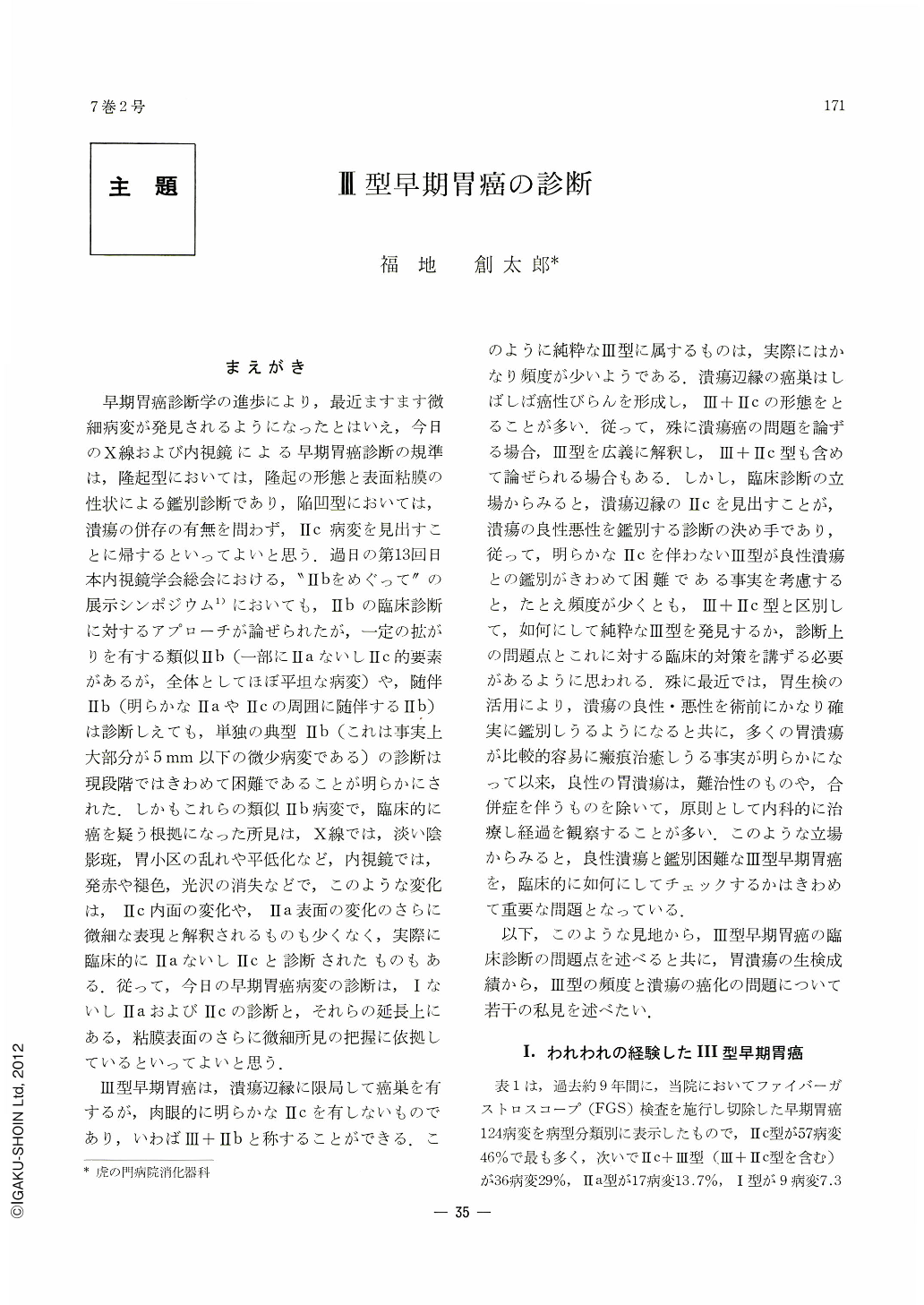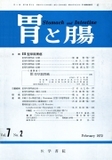Japanese
English
- 有料閲覧
- Abstract 文献概要
- 1ページ目 Look Inside
まえがき
早期胃癌診断学の進歩により,最近ますます微細病変が発見されるようになったとはいえ,今日のX線および内視鏡による早期胃癌診断の規準は,隆起型においては,隆起の形態と表面粘膜の性状による鑑別診断であり,陥凹型においては,潰瘍の併存の有無を問わず,Ⅱc病変を見出すことに帰するといってよいと思う.過日の第13回日本内視鏡学会総会における,“Ⅱbをめぐって”の展示シンポジウムにおいても,Ⅱbの臨床診断に対するアプローチが論ぜられたが,一定の拡がりを有する類似Ⅱb(一部にⅡaないしⅡc的要素があるが,全体としてほぼ平坦な病変)や,随伴Ⅱb(明らかなⅡaやⅡcの周囲に随伴するⅡb)は診断しえても,単独の典型Ⅱb(これは事実上大部分が5mm以下の微少病変である)の診断は現段階ではきわめて困難であることが明らかにされた.しかもこれらの類似Ⅱb病変で,臨床的に癌を疑う根拠になった所見は,X線では,淡い陰影斑,胃小区の乱れや平低化など,内視鏡では,発赤や褪色,光沢の消失などで,このような変化は,Ⅱc内面の変化や,Ⅱa表面の変化のさらに微細な表現と解釈されるものも少くなく,実際に臨床的にⅡaないしⅡcと診断されたものもある.従って,今日の早期胃癌病変の診断は,ⅠないしⅡaおよびⅡcの診断と,それらの延長上にある,粘膜表面のさらに微細所見の把握に依拠しているといってよいと思う.
Ⅲ型早期胃癌は,潰瘍辺縁に限局して癌巣を有するが,肉眼的に明らかなⅡcを有しないものであり,いわばⅢ+Ⅱbと称することができる.このように純粋なⅢ型に属するものは,実際にはかなり頻度が少いようである.潰瘍辺縁の癌巣はしばしば癌性びらんを形成し,Ⅲ+Ⅱcの形態をとることが多い.従って,殊に潰瘍癌の問題を論ずる場合,Ⅲ型を広義に解釈し,Ⅲ+Ⅱc型も含めて論ぜられる場合もある.しかし,臨床診断の立場からみると,潰瘍辺縁のⅡcを見出すことが,潰瘍の良性悪性を鑑別する診断の決め手であり,従って,明らかなⅡcを伴わないⅢ型が良性潰瘍との鑑別がきわめて困難である事実を考慮すると,たとえ頻度が少くとも,Ⅲ+Ⅱc型と区別して,如何にして純粋なⅢ型を発見するか,診断上の問題点とこれに対する臨床的対策を講ずる必要があるように思われる.殊に最近では,胃生検の活用により,潰瘍の良性・悪性を術前にかなり確実に鑑別しうるようになると共に,多くの胃潰瘍が比較的容易に瘢痕治癒しうる事実が明らかになって以来,良性の胃潰瘍は,難治性のものや,合併症を伴うものを除いて,原則として内科的に治療し経過を観察することが多い.このような立場からみると,良性潰瘍と鑑別困難なⅢ型早期胃癌を,臨床的に如何にしてチェックするかはきわめて重要な問題となっている.
以下,このような見地から,Ⅲ型早期胃癌の臨床診断の問題点を述べると共に,胃潰瘍の生検成績から,Ⅲ型の頻度と潰瘍の癌化の問題について若干の私見を述べたい.
Type Ⅲ early gastric cancer, having its cancer nests localized only on the margins of the excavation, can also be interpreted as Ⅲ+Ⅱb type since it is not associated with distinct Ⅱc. In the discussion of “ulcer-cancer”, type Ⅲ is apt to be regarded in a broader sense of its definition including also type Ⅲ+Ⅱc. However, seen from the standpoint of clinical diagnosis, strict distinction should be made between type Ⅲ and type Ⅲ+Ⅱc. Only then would our measures for its detection and for its still unsolved problems be justified.
Of 124 cases of early gastric cancer found by us, type Ⅲ was seen only in three (2.4%). In all of them no malignant changes were noticed either by x-ray, endoscopy or gross findings of the removed stomach. Two were found at a time when biopsy was as yet introduced. The third was confirmed only by biopsy.
On the other hand, a total of 611 biopsies were attempted on 398 cases (435 lesions) of gastric ulcer and on 111 cases of ulcer scar, but after all no malignancy was to seen. Type Ⅲ early cancer is thus assumed to be quite infrequent.
Endoscopically, this variety is very difficult to discriminate from benign ulcer. Because no definite macroscopical criteria are as yet established, all cases of chronic gastric ulcer become the object of differential diagnosis. For the detection of type Ⅲ we must perform biopsy on all cases of gastric ulcer periodically at a certain time even when no malignancy is grossly apparent.
Most of type Ⅲ early gastric cancer belong to the category of “ulcer-cancer” as defined by Hauser, but our cases seem to suggest that it could arise by acute exacerbation of gastric ulcer in the course of its malignant cycle.
Regarding the question whether gastric ulcer can become cancerous, our results in the clinical follow-up of many ulcer cases have shown no definite evidence yet to prove that benign ulcer can become cancerous.
Nevertheless, because not only clinical follow-up studies hitherto employed are limited in their methods, but also histopathological investigations are at fault in the chronological follow-up of ulcer courses, the most important measures left for us in the timely diagnosis of type Ⅲ early gastric cancer are detailed long-term follow up of ulcer cases not only by x-ray but also by endoscopy as well as biopsy.

Copyright © 1972, Igaku-Shoin Ltd. All rights reserved.


